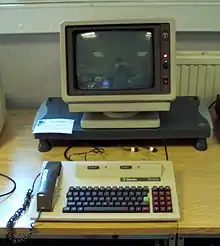 Merlin Tonto | |
| Also known as | OPD, Merlin Tonto, Computerphone |
|---|---|
| Manufacturer | International Computers Limited (ICL) |
| Type | personal computer / telecommunications terminal |
| Release date | 1984 |
| Operating system | BFS ("Basic Functional Software") |
| CPU | Motorola 68008 |
| Memory | 128 KB |
| Storage | 2× Microdrive |
| Graphics | ZX8301 |
| Sound | TMS5220 speech synthesiser |
| Connectivity | V.21/V.23 modem |

The One Per Desk, or OPD, was an innovative hybrid personal computer/telecommunications terminal based on the hardware of the Sinclair QL.[1] The One Per Desk was built by International Computers Limited (ICL) and launched in the United Kingdom in 1984.[2] It was the result of a collaborative project between ICL, Sinclair Research and British Telecom begun in 1983,[3] originally intended to incorporate Sinclair's flat-screen CRT technology.
Rebadged versions of the OPD were sold in the United Kingdom as the Merlin Tonto[4] and as the Computerphone by Telecom Australia[5] and the New Zealand Post Office.[6] The initial orders placed for the One Per Desk were worth £4.5 million (for 1500 units) from British Telecom and £8 million from Telecom Australia, with ICL focusing on telecommunications providers as the means to reach small- and medium-sized businesses.[7] Sales of the OPD worth $42 million were reportedly made by ICL within the first nine months of the product becoming available, largely involving contracts with British Telecom and the telecommunications authorities of Australia, Hong Kong and New Zealand.[8]
Hardware
From the QL, the OPD borrowed the 68008 CPU, ZX8301/8302 ULAs, 128 KB of RAM and dual Microdrives (re-engineered by ICL for greater reliability) but not the Intel 8049 Intelligent Peripheral Controller. Unique to the OPD was a "telephony module" incorporating an Intel 8051 microcontroller (which also controlled the keyboard), two PSTN lines and a V.21/V.23 modem, plus a built-in telephone handset and a Texas Instruments TMS5220 speech synthesiser (for automatic answering of incoming calls).[9][10]
The OPD was supplied with either a 9-inch monochrome (white) monitor, priced at £1,195 plus VAT, or with a 14-inch colour monitor, priced at £1,625 plus VAT.[11] Both monitors also housed the power supply for the OPD itself.
Later, 3.5" floppy disk drives were also available from third-party vendors.
Software
The system firmware (BFS or "Basic Functional Software") was unrelated to the QL's Qdos operating system, although a subset of SuperBASIC was provided on Microdrive cartridge. The BFS provided application-switching, voice/data call management, call answering, phone number directories, viewdata terminal emulation and a simple calculator.
The Psion applications suite bundled with the QL was also ported to the OPD as Xchange and was available as an optional ROM pack, priced at £130.[11]
Other optional application software available on ROM included various terminal emulators such as Satellite Computing's ICL7561 emulator, plus their Action Diary and Presentation Software, address book, and inter-OPD communications utilities.[10]
An ICL supplied application was used to synchronise a national bingo game across hundreds of bingo halls in the UK. The integral V.23 dialup modem was used to provide remote communications to the central server.
Several UK ICL Mainframe (Series 39) customers, in Local Government and Ministry of Defence sectors, used statistics applications on OPD systems to view graphical representations of mainframe reports. Once again, the integral V.23 modem was used to download from the mainframe.
Merlin Tonto
British Telecom Business Systems sold the OPD as the Merlin M1800 Tonto.[12] BT intended the Tonto to be a centralised desktop information system able to access online services, mainframes and other similar systems through the BT telephone network. The Tonto retailed at £1,500 at launch. OPD peripherals and software ROM cartridges were also badged under the Merlin brand. BT withdrew support for the Tonto in February 1993. The name Tonto was derived from "The Outstanding New Telecoms Opportunity"[13]
A data communications adapter was introduced for the Tonto as a plug-in option or fitted on new units, providing a standard RS423 interface for use with mainframe computers or data communications networks, permitting the use of the Tonto as a VT100 terminal. A separate VT Link product provided support for VT52 and VT100 emulation for mainframe access over dial-up connections.[14]
Work on the Tonto influenced the design of a follow-on product by BT's Communications Terminal Products Group and Rathdown Industries known as the QWERTYphone,[15] this aiming to provide the telephony features of the Tonto at "a much lower cost and in a more user-friendly manner".[16]
ComputerPhone
Aimed at the "office automation" market and seeking to integrate computing and telecommunications technology, combining support for both voice and data, the One Per Desk product was perceived as the first of its kind designed to meet the needs of managers, who would be relying on old-fashioned paper-based practices to perform their "complex and heavy workloads" involving a variety of ongoing activities including meetings, telephone calls, research, administration and numerous other tasks. Such potential users of information technology had apparently been ignored by office automation efforts, and personal computers were perceived as "exceeding most managers' requirements". The ComputerPhone attempted to sit between more specialised telephony devices and more advanced workstations, being marketed as an "executive" workstation in Australia, somewhat more towards middle management in New Zealand.[17] Advertisements emphasised the telephony, office suite, desktop calculator, videotex, terminal and electronic messaging capabilities.[18]
MegaOPD
An enhanced version of the OPD was produced in small numbers for the United States market. This had a 68008FN CPU, 256 KB of RAM as standard, an RS-232 port and enhanced firmware.[19][20] The telephone answering function had a female voice, with a slight New Jersey accent.
Legacy
ICL were the preferred supplier for UK local government, and OPDs found their way onto desks of council officers. Due to the cost, they tended to be issued only to the most senior, who were often elderly, had no interest in computers, and had secretaries to handle their administrative work, so many devices were simply used as telephones.
References
- ↑ The Register: Sinclair's FORGOTTEN Australia-only micro revealed!
- ↑ Tebbutt, David (December 1984). "ICL OPD". Personal Computer World. pp. 120–124, 126. Retrieved 12 September 2020.
- ↑ Holmes, S. P. (January 1987). "Merlin Tonto". British Telecommunications Engineering. 5 (4): 273–275. ISSN 0262-401X. Retrieved 26 February 2021.
- ↑ "Tonto". British Telecommunications Engineering. 4 (1): 57. April 1985. ISSN 0262-401X. Retrieved 26 February 2021.
- ↑ Tebbutt, David (January 1985). "ComputerPhone". Australian Personal Computer. pp. 14–16, 18, 23, 25–26. Retrieved 9 October 2020.
- ↑ Bisman, Laurie (October 1985). "A 'phone' with the right connections". Bits & Bytes. pp. 30–40. Retrieved 25 March 2021.
- ↑ "Where PC meets telecomms". Computer Business. February 1985. p. 18. Retrieved 29 March 2021.
- ↑ "British Make a Big Push in Phone-Computers". Electronics. 23 December 1985. p. 24. Retrieved 23 May 2023.
- ↑ "ICL OPD — One Per Desk". OLD-COMPUTERS.COM. Retrieved 23 April 2008.
- 1 2 "A full technical breakdown of the OPD by Murray McCabe". Binary Dinosaurs. Retrieved 23 April 2008.
- 1 2 "Microdrive storage mars OPD concept". Personal Computer News. November 1984. p. 4. Retrieved 27 March 2021.
- ↑ "Merlin Tonto". OLD-COMPUTERS.COM. Retrieved 23 April 2008.
- ↑ "BT Merlin Tonto". computinghistory.org.uk. Retrieved 25 November 2014.
- ↑ "Mainframe Access for Merlin Tonto". British Telecommunications Engineering. 4 (3): 183. October 1985.
- ↑ "BT QWERTYPHONE". BOBS TELEPHONE FILE. 28 November 2010. Retrieved 13 March 2021.
- ↑ Durkin, G. M. (January 1987). "QWERTYphone - A Low-Cost Integrated Voice/Data Terminal". British Telecommunications Engineering. 5 (4): 276–280. ISSN 0262-401X. Retrieved 26 February 2021.
- ↑ Pears, Beryl (October 1985). "Who would want ComputerPhone?". Bits & Bytes. pp. 43–44. Retrieved 25 March 2021.
- ↑ "If you suffer from chronic disorganisationitus..." Bits & Bytes. November 1985. p. 37. Retrieved 25 March 2021.
- ↑ "'Mega' OPD". www.SinclairComputers.com. Archived from the original on 18 June 2007. Retrieved 23 April 2008.
- ↑ "MegaOPD unearthed". QUANTA. Archived from the original on 21 August 2008. Retrieved 23 April 2008.
External links
- "OPD page". SinclairComputers.com. Archived from the original on 2 December 2007.
- Description of Merlin Tonto from BT Engineering
- ICL One Per Desk page at rwapsoftware.co.uk including a floppy disk project

